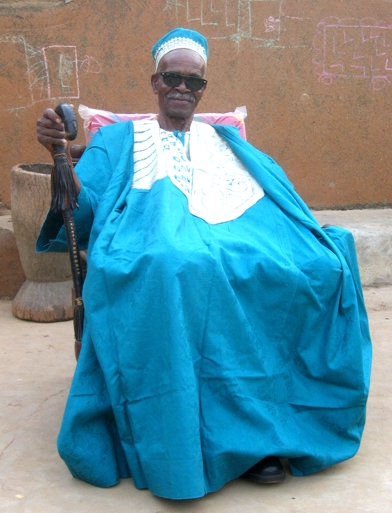
Franz Kröger

The teng-nyono and the Anthropologist
It was only by accident, when I met Anamogsi and his father Anyenangdu the first time in 1973. I had attended a wen-piirika celebration (the descent of the divine wen from heaven) in Asik Yeri, the native compound of my friend and then main informant, Mr Leander Amoak. In the break between the morning sacrifices and the offerings of warm food (saab, T.Z.) in the afternoon, Mr. Leander Amoak proposed paying a visit to Anyenangdu, the very old teng-nyono (earth priest) of Badomsa. On this occasion I took several photos of Anyenangdu (not knowing that he would die a few months later), interviewed him on Babatu and the slave raids and also met his young and active son, Anamogsi, who gave us some information about his native medicine. When Anamogsi told me that we (Leander and I) should visit him if there were any questions, I felt that this was not a polite phrase but a sincere offer. In 1984 I wished to spend some time in a native compound. Of course Leander Amoak would have allowed me to live in his traditional compound (Asik Yeri), but at that time it was very small and Leander himself lived in Wiaga-Goansa, the centre of Wiaga. So I asked him in a letter to inquire among the yie-nyam (house owners) which of them would be ready to host me for at least a few weeks. In his return letter I learnt that Anamogsi, then teng-nyono, would be happy to host me for as long as I liked and that I was free to observe whatever ritual was performed in his compound. From this time on I gave up any plans to live in a guest-house again and spent all the time of my frequent visits in Buluk (1988-2011) only in Anyenangdu Yeri.
After some time he told me that he would regard me as his (senior) son. I had heard this
phrase several times by friendly old men and did not pay extraordinary attention to it. Only
later I realized that his offer had a different weight, that it was meant in a more intimate sense
than the remarks of other old people. I experienced it when I expected various visitors (white
and African), some of whom were eager to view a native Bulsa compound with all its shrines,
ancestral rooms, etc. Therefore I asked Anamogsi whom I should ask for permission in such
a case if he himself was not at home. “Any of my sons can allow it, and of course also you as
my senior son”, he said. When a white friend came for a visit and Anamogsi was at
home, I told him that we would have a tour of the compound including the kpilima dok
(ancestors’ room with many shrines). He laughed and said I should not be too anxious. I
might do this without informing him.
Being the son of a ‘big man’ was very advantageous for my work. When Anamogsi was invited by another Badomsa family to a burial, he encouraged me to join him. I told him to also ask for that family’s permission for me to take part in the burial rites. He laughed again: “If they invite me, they cannot prohibit my son from joining me”.
Although Anamogsi was a member of the old, traditional Bulsa society, he managed to combine his position as an elder (kpagi), compound owner (yeri nyono), earth-priest (teng nyono) and medicine-man (tiim nyono) with an extraordinary open-mindedness for all modern tendencies and technical innovations. His authority and power was vested in the old traditional society, but nevertheless he made the long journey to Accra only to attend the meeting for electing a presidential candidate of his party (NPP).
When, for the first time, I joined Anamogsi in offering a sacrifice to Pung Muning, the famous earth-shrine (tangggbain), I asked him whether I could place my tape recorder in front of him so that it could record all the prayers and incantations while I took photos from some distance away. He answered that he himself would take over the recording of all important parts of the sacrifice and here and in all further sacrifices he proved to be a clever technical assistant.
Even in his eighties he acquired a strong motor-bike to enable himself, his adult sons (including the author) and his wives (as pillion riders) a comfortable means of transportation.
Although in his last years Anamogsi had to suffer from several unfortunate blows of fate, he did not give up his friendly and humorous way of life. He died after a short fatal disease on July 15th, 2010.
After his death, people of Anyenangdu Yeri assured me that I could continue my stays in their compound, but nothing will again be as it was in Anamogsi’s lifetime. In Baba, as he was also called by his family, I lost a good father-like friend, the host of my stays in Bulsaland and the main informant for my anthropological research work.